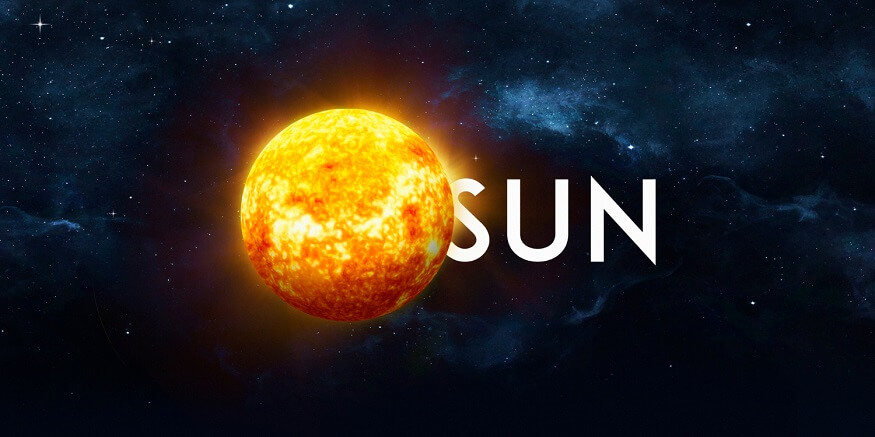The Sun is a magnificent star planet in the middle of our solar system. The solar system includes the sun and space objects that circle it, such as planets, moon, small planets, and falling stars. Its brilliant magnificence and great strength have sparked interest and research. Kids should witness dazzling solar flares, discover the secrets of sun facts, learn how the Sun influences our daily lives, and learn more unbelievable information about the Sun and also interesting facts about the Sun.
Also Read: Tips To Get Children Interested In Space Science
Interesting Facts About the Sun:
A Cosmic Powerhouse:
The Sun is an astoundingly powerful entity, generating an estimated 386 billion megawatts of energy per second! This amazing output is the effect of nuclear fusion, in which hydrogen atoms combine to generate helium, releasing huge quantities of energy in the process.
A Giant Ball of Gas:
The interesting facts about the Sun is, despite its fiery appearance, the Sun is primarily composed of gas. Approximately 74% of its mass is hydrogen, while helium makes up about 24%. The remaining 2% consists of trace amounts of heavier elements.
The Centre of the Solar System:
Our solar system’s essential and greatest object is the Sun. Its huge bulk produces a gravitational pull on all planets, moons, and other celestial bodies, maintaining them in orbit around it.
The Sun’s colour:
Although the Sun appears white when viewed from space, its light appears yellow due to Earth’s atmosphere scattering shorter blue and violet wavelengths. The Sun has been identified by researchers as a G-type main-sequence star, sometimes known as a “yellow dwarf.”
The Roaring Flames:
The solar flares are bright outbursts that occur on the Sun’s surface. Massive quantities of energy are released in the form of electromagnetic energy, primarily radiation, and ultraviolet light, during these volcanic events. Solar flares have the capacity to destroy Earth’s satellites, power lines, and communication systems.
Sunspots:
Sunspots are amazing sun facts, which are cooler, darker areas that appear on the Sun’s surface. These temporary phenomena occur when intense magnetic activity inhibits the transport of heat, causing localised cooling. Sunspots can expand to be a lot the size of Earth and can remain present for weeks or even months.
Also Read: Interesting Facts about Space for Kids
A Solar Spin:
The Sun rotates, but its rotation is not uniform. The equator completes one rotation in about 24.5 Earth days, while the poles take around 36 Earth days. This phenomenon is known as differential rotation.
The Sun’s Protective Shield:
The magnetic field is created by the Sun’s shaking, electrically conducting plasma. This magnetic field extends well beyond the visible surface of the Sun, producing the heliosphere. The heliosphere protects our solar system from the large bulk of galactic cosmic radiation.
Dancing Lights:
One of the amazing facts about the Sun is the solar wind. A solar wind is a flow of electrically charged particles produced by the Sun. These particles move fast, escaping the Sun’s incredible attraction and speeding through the whole solar system. When the solar wind interacts with the Earth’s magnetosphere, it may cause amazing dancing lights, which are aurora borealis and aurora australis.
Superstorms on the Sun:
Solar storms, also known as coronal mass releases, are massive eruptions of plasma and magnetic fields from the Sun’s corona. These massive events have the ability to send billions of tonnes of particles into orbit and damage satellite communications and electrical infrastructure on Earth.
The Sun’s Changing Face:
The Sun undergoes an 11-year solar cycle characterised by a fluctuation in sunspot activity. The number of sunspots and solar flares is largest during the top of this cycle, known as solar highest, while the Sun is generally calm during solar minimum, with few sunspots and flares.
A Glimpse into Solar Anatomy:
The Sun is composed of several distinct layers. The core is the central region where nuclear fusion occurs, generating the Sun’s energy. Surrounding the core is the radiative zone, followed by the convective zone, where energy is transported through the movement of plasma. The outermost layer visible from Earth is the photosphere, giving the Sun its characteristic appearance.
Size Comparison:
Nearly 1.3 million Earths might fit within the Sun! It is nearly 109 times larger than Earth, with a diameter of around 870,000 miles.
The Sun’s Far-Reaching Influence:
One of the most important sun facts is that the Sun’s influence extends far beyond its visible surface. Its gravitational pull holds each planet in its cycles and plays an important role in creating Earth’s temperature and weather. If there was no energy from the Sun, there would be nothing living as we know it.
A Symbol of Life and Mythology:
Throughout history, the Sun has been revered and worshipped by various cultures worldwide. It symbolises vitality, power, and the cycle of life. In many mythologies, the Sun is personified as a deity, shedding light and warmth upon the Earth.
Also Read: Science Stream Career Options after 10th & List of Courses after 12th
Conclusion:
We hope you are mesmerised by the information about the Sun. From its scorching temperatures to its immense size and astonishing power, the Sun continues to entertain and astound us. At EuroSchool, we encourage our students to always look up and appreciate the celestial wonders and amazing facts about the Sun. There is a lot of information about the Sun that has to be found, so keep exploring, keep learning, and let the wonders of the Sun inspire you to reach for the stars!









